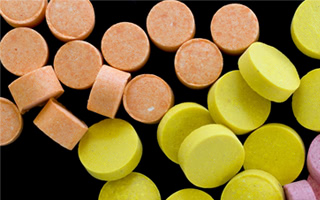Phencyclidine (PCP)
Phencyclidine is a recreational drug that was marketed in the 1950s as an anesthetic pharmaceutical drug. It was taken off the market due to its dissociative hallucinogenic side effects. It began to appear as a drug of abuse in major American cities in 1967, called PCP, two years after it was banned. It still has limited use in veterinary practice. Although abuse of PCP has declined over the years, it is still considered a major drug of abuse because of the intensity of its effects and the potential for overdose in its illegal form. PCP has a history of causing hallucinations, paranoia, and extreme violent and self-destructive behavior in users. Abuse is a particular problem for law enforcement since the analgesic effect makes violent abusers highly resistant or impervious to pain when under the influence, so they are difficult for police to control.
Abuse and Detection
PCP is administered in a variety of ways. In its pure or freebase form, it is a yellow oil, sometimes called embalming fluid, into which cigarettes are dipped or it is sprayed onto herbs and smoked. The oil can be converted into white or tan crystals or powder for snorting like cocaine. Illegal manufacturing often introduce contaminants, many of which are toxic, increasing the danger to the abuser. The dissociative hallucinatory effects create a sense of detachment from the environment and from reality. Combined with the analgesic effects, some users are driven to self-mutilation, such as the removal of teeth. There are even notorious incidents of murder and cannibalism, as well as psychotic episodes lasting up to several months.
Common street names:
Angel Dust, PeaCe Pill, hog, lovely, wack, ozone, dust, embalming fluid, Rocket Fuel; smokeable productsupergrass, killer joints, boat, water, fry stick, sherm, dipper, amp
Paraphernalia:
foil wrappers or packets, oil vials, pipes, joints
slurred speech, loss of coordination, hallucinations, out-of-body experiences, inability to feel pain, extreme aggression, fear, paranoia, panic, suicidal impulses
Medical Dangers:
numbness, depressed respiration, depression, increased risk of accidents, self-harm, suicide
Testing Medium:
Urine, hair, and oral fluid
Window of Detection
urine 5-10 days; hair up to 90 days, depending on hair length; oral fluid 1-3 days

